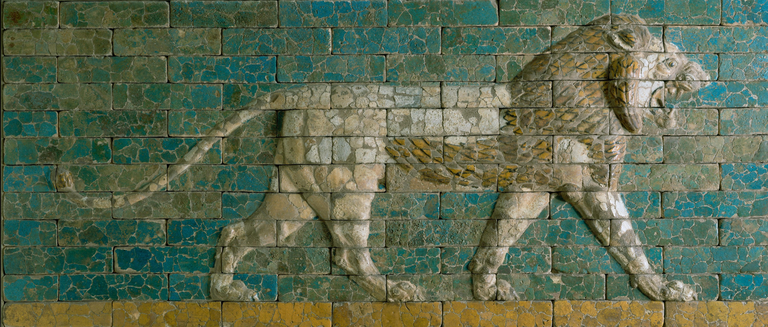A Wonder to Behold: The Power of Craftsmanship and the Creation of Babylon’s Ishtar Gate
This article by Rachel Herschman first appeared in ISAW Newsletter 24, Spring 2019.
 Lion Panel from the Ishtar Gate Processional Way, 604-562 BCE, Babylon. Baked clay and glaze. The Metropolitan Museum of Art, Fletcher Fund, 1931:31.13.2.
Built by King Nebuchadnezzar II (r. 604-562 BCE), excavated by German archaeologists and partially re-created at the Vorderasiatisches
Lion Panel from the Ishtar Gate Processional Way, 604-562 BCE, Babylon. Baked clay and glaze. The Metropolitan Museum of Art, Fletcher Fund, 1931:31.13.2.
Built by King Nebuchadnezzar II (r. 604-562 BCE), excavated by German archaeologists and partially re-created at the Vorderasiatisches
Museum in Berlin in the early 20th century, the Ishtar Gate has become an icon of ancient architectural achievement. A Wonder to Behold approaches this well-known monument from a fresh perspective: featuring a process-oriented exploration of the gateway’s creation. This exhibition will focus on the role of craftspeople and the magic of materials in ancient Near Eastern life. The Ishtar Gate and its affiliated Processional Way were intended not only to ritually protect the city, but also, in the words of the King, to evoke a sense of “wonder” in “all peoples.”
The creation of this powerful architectural complex was made possible by technological advancements as well as an engagement with longstanding artistic processes and religious practices. Panels depicting lions, bulls, and dragons were technically demanding—assembled like puzzles, such works required careful planning and production—and the beasts were “magically” activated through the use of clay, glaze, and molding technology. The craftspeople who designed the Ishtar Gate and Processional Way were more than highly skilled technicians: as religious specialists and scholars, they were members of society who had knowledge of, and access to, the sacred past. Ancient Near Eastern craftspeople created objects that called upon the powers of both the human and divine realms.
Co-curated by Clare Fitzgerald, Anastasia Amrhein, and Elizabeth Knott, this exhibition will feature approximately 150 artworks including a panel and fragments from the Ishtar Gate and Processional Way, molded and glazed architectural elements, terracotta figurines and plaques, glass vessels, cylinder and stamp seals, amulets, jewelry, raw materials, artists’ tools, and cuneiform recipe tablets, as well as modern watercolors, sketches, and photographs. A Wonder to Behold reconsiders the Ishtar Gate as testament to the transformatitive power of making and materials.